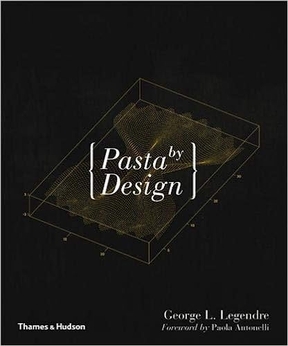Pasta by Design facts for kids
 |
|
| Author | George L. Legendre |
|---|---|
| Illustrator | Photography by Stefano Graziani |
| Language | English |
| Publisher | Thames & Hudson |
|
Publication date
|
November 2011 |
| ISBN | 978-0-500-51580-8 |
Pasta by Design is a unique book by George L. Legendre. It features a foreword by Paola Antonelli and amazing photos by Stefano Graziani. The idea for the book came from Marco Guarnieri.
Contents
What is Pasta by Design?
Pasta by Design connects the worlds of architecture, food, and popular science. The book shows off 92 different pasta shapes. For each shape, you'll find a photograph, a mathematical equation, a 3D picture, and a short description. This description tells you where the pasta comes from and how to cook it. The book was first released in 2011 by Thames & Hudson in London. A German version came out in 2012.
How Pasta Shapes are Organized
This book is mainly about taxonomy, which is the science of classifying things. It organizes the many different pasta shapes in a special way. To do this, it uses ideas from phylogenetics. Phylogenetics is a way to study how different things are related and how they developed over time.
The book starts with a special chart that looks like a family tree. This chart helps to classify the 92 pasta shapes. It shows how shapes that look very different might actually be related through their mathematical descriptions.
The Math Behind Pasta Shapes
The main way the book classifies pasta is by looking at its morphology, or its shape. Each pasta shape is broken down into its basic parts. These parts are then described using simple math.
For example, two pasta shapes like Sagne Incannulate and Cappelletti might look different. But they can be described using the same mathematical rules. This means they are more closely related than you might think! The book suggests that all the many pasta shapes can be understood using simple math.
Technically, each shape is shown using three parametric equations. These equations use just two basic math functions: sine and cosine. Parametric equations are a powerful tool that can describe any 3D shape. The math in the book isn't just for pasta. It's a way to model many different forms.
Pasta as Art and Science
Pasta by Design shows how pasta has become a topic for deep study. People now see pasta not just as food, but also as a design icon. This book is part of a bigger trend where food is becoming more important in society and culture.
Paola Antonelli, a design expert, explains this idea well. She says that in our world today, "seeing mathematics in fusilli makes perfect sense." This is because programmers talk about beautiful code, and designers use math to create organic shapes. The book shows how many creative people are now interested in math and science. This trend is also seen in architecture, where designers use math to model forms. It's also clear in cooking, with the rise of molecular gastronomy. This field uses science to understand and change food.

